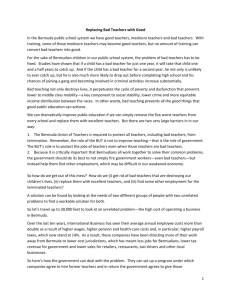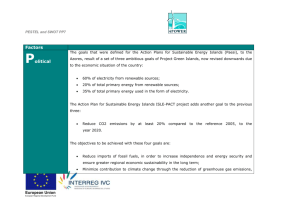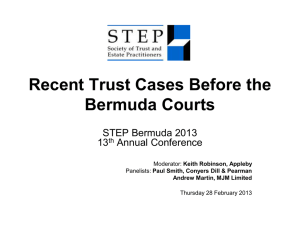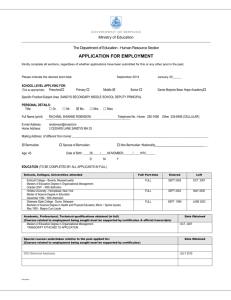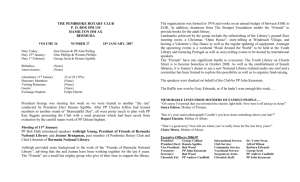On From Bermuda
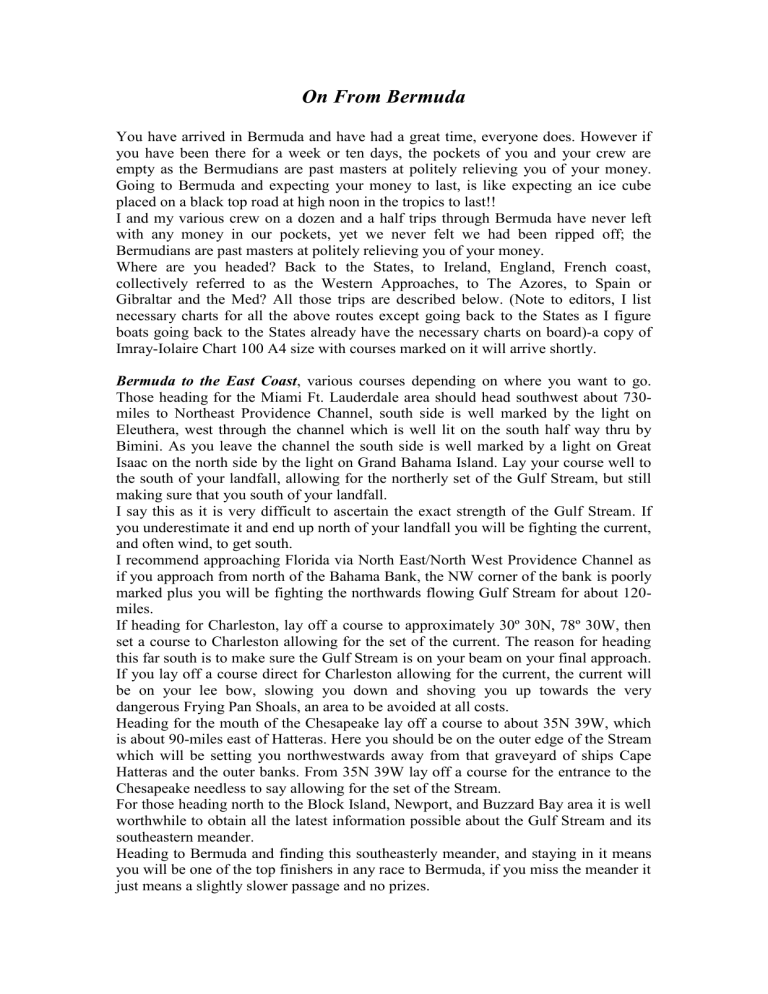
On From Bermuda
You have arrived in Bermuda and have had a great time, everyone does. However if you have been there for a week or ten days, the pockets of you and your crew are empty as the Bermudians are past masters at politely relieving you of your money.
Going to Bermuda and expecting your money to last, is like expecting an ice cube placed on a black top road at high noon in the tropics to last!!
I and my various crew on a dozen and a half trips through Bermuda have never left with any money in our pockets, yet we never felt we had been ripped off; the
Bermudians are past masters at politely relieving you of your money.
Where are you headed? Back to the States, to Ireland, England, French coast, collectively referred to as the Western Approaches, to The Azores, to Spain or
Gibraltar and the Med? All those trips are described below. (Note to editors, I list necessary charts for all the above routes except going back to the States as I figure boats going back to the States already have the necessary charts on board)-a copy of
Imray-Iolaire Chart 100 A4 size with courses marked on it will arrive shortly.
Bermuda to the East Coast , various courses depending on where you want to go.
Those heading for the Miami Ft. Lauderdale area should head southwest about 730miles to Northeast Providence Channel, south side is well marked by the light on
Eleuthera, west through the channel which is well lit on the south half way thru by
Bimini. As you leave the channel the south side is well marked by a light on Great
Isaac on the north side by the light on Grand Bahama Island. Lay your course well to the south of your landfall, allowing for the northerly set of the Gulf Stream, but still making sure that you south of your landfall.
I say this as it is very difficult to ascertain the exact strength of the Gulf Stream. If you underestimate it and end up north of your landfall you will be fighting the current, and often wind, to get south.
I recommend approaching Florida via North East/North West Providence Channel as if you approach from north of the Bahama Bank, the NW corner of the bank is poorly marked plus you will be fighting the northwards flowing Gulf Stream for about 120miles.
If heading for Charleston, lay off a course to approximately 30º 30N, 78º 30W, then set a course to Charleston allowing for the set of the current. The reason for heading this far south is to make sure the Gulf Stream is on your beam on your final approach.
If you lay off a course direct for Charleston allowing for the current, the current will be on your lee bow, slowing you down and shoving you up towards the very dangerous Frying Pan Shoals, an area to be avoided at all costs.
Heading for the mouth of the Chesapeake lay off a course to about 35N 39W, which is about 90-miles east of Hatteras. Here you should be on the outer edge of the Stream which will be setting you northwestwards away from that graveyard of ships Cape
Hatteras and the outer banks. From 35N 39W lay off a course for the entrance to the
Chesapeake needless to say allowing for the set of the Stream.
For those heading north to the Block Island, Newport, and Buzzard Bay area it is well worthwhile to obtain all the latest information possible about the Gulf Stream and its southeastern meander.
Heading to Bermuda and finding this southeasterly meander, and staying in it means you will be one of the top finishers in any race to Bermuda, if you miss the meander it just means a slightly slower passage and no prizes.
However going in the other direction, stumbling into this southeasterly meander can stop you almost dead. In 1960 on Iolaire heading north in the days when they were just discovering about this southeasterly meander, we hit it going north and it certainly slowed us down. In 1975 heading north, we hit it dead on which stopped us almost dead. The Tarrafal log read 120-miles; celestial navigation showed we had made only 45-miles more than a little frustrating to say the least.
If you do not have it on board, I would strongly recommend that you purchase from
Armchair Bookstore Newport RI that wonderful little booklet Gulf Stream
Companion a series of articles about the Gulf Stream printed by Ocean Navigator.
Bermuda to Europe. The voyage from Bermuda to The Azores must not be taken before the end of May because of the winter gales, whose frequency in early May in the North Atlantic is in the opinion of most experience mariners too high to be risked.
Even in the last week of May and the month of June you may catch a gale or the edge of one, especially as you approach The Azores; but it should be north of you, and therefore a westerly gale, which will be blowing you on your way-see Gale Frequency
Chart on the back of the Imray-Iolaire Chart 100.
All one has to do is to look at the North Atlantic weather chart and one realises that if one leaves late May or early June you have a good chance of getting to the Azores and possibly on to Europe without going through a gale. Unless you are extremely unlucky you will only be caught in one gale at the most.
Those boats that leave in late April or early May are not only GUARANTEED getting a gale, but most probably they will experience two gales before getting across to Europe. Those gales in late April early May are likely to be very severe. I think few seaman will disagree with the statement, “once it starts blowing over 50 knots, the survival of the boat and crew is
1
/
3rd
down to good seamanship,
1
/
3rd
good boat and
1 /
3rd
S.A.L. (Shit Ass Luck). Thus try to avoid gales, and especially severe gales as found in March, April and early May.
Do not approach Western approaches until late June when the gale frequency is much lower than earlier in the year.
In July the gale frequency becomes even lower, but the chance of catching the edge of a hurricane increases. Thus there is a relatively small window of safe and comfortable conditions for this voyage.
Bermuda Direct to Western Approaches , use Imray-Iolaire chart 100, boats should not leave Bermuda until the last week in May or better the first week in June when the gale frequency on this route has eased off.
The amount of money that underwriters have paid out on heavy weather damage and lost boats in late April and early May in the area between Bermuda and the Western
Approaches makes one wonder why they even insure boats in this area at that time.
Bermuda to the western approaches, sail the Great Circle route, 2,660-miles from
Bermuda to Mizzen Head, but note the great circle course on Imray-Iolaire chart 100.
You will see that the Great Circle Course leads THRU the southern edge of where icebergs and growlers can be expected-you will be in the area for about 600-miles.
Thus before you leave Bermuda ascertain how you can obtain ice reports, monitor the southern edge of the iceberg growlers area and adjust your course accordingly.
The actual iceberg growler area can vary considerably from year to year; there are no hard and fast rules.
Note the triangles on the Imray Chart 100, these triangles show the location of icebergs that have drifted out of the normal iceberg area, note that many of them are
SOUTH of The Azores, and one almost reached Bermuda.
The N.O.A.A chart noted the years of the odd icebergs from 1912 to 1935. Since that time they have stopped dating them. If anyone can tell me how I can obtain the dates of the odd icebergs, I would appreciate it and we would note the dates of all icebergs on the Imray-Iolaire Chart 100.
If you are sailing along outside of the iceberg area, in clear weather and you run into fog, WATCH OUT you may discover you are in the area of an odd iceberg . One friend tells the story of sailing along in bright sunshine and ideal conditions, when suddenly he ran into a fog bank, he thought nothing of it. Luckily was standing watches as suddenly right in front of him was a huge ice berg.
He was close hauled on starboard tack, wind south east course east, upon sighting the ice berg he tacked south immediately, within fifteen or twenty minutes the fog dissipated and the sun came out with perfect conditions, he tacked back and continued east.
When he spotted the ice berg he was close enough to hear the sea breaking on the ice berg and hear pieces falling off it.
If you suddenly run into fog in clear weather be careful an ice berg may be near by.
Note on Imray-Iolaire chart 100 the number of ice bergs outside the normal ice berg area.
On this route you should have fair wind all the way, it will be cold with fog in the middle of the trip, but the last few days it can often be crystal clear, warm, almost like the tropics.
For much of the trip on this route you will be getting a lift from the Gulf Stream of ¾ to 1 kt and the water may be fairly warm. It is worth keeping track of the water temperature to try and stay in the Stream.
Approaching Ireland see Imray C17 which covers Ireland to France with insets for
Crookhaven, Falmouth and Brest.
I highly recommend that you make a quick left turn and duck into Crookhaven. Why would any sailor pass up Ireland, continue on another two days to England and
Falmouth to discover, the Beer warm, a cricket game in progress and the pub closed.
Two things an American can never comprehend is the game of Cricket and the
English pub hours. (In Falmouth the pub hours are about the worst in the entire United
Kingdom) and if the pub is open the beer is warm!!
If you do bypass by Ireland and the weather permits, I would duck into the incomparable Scilly Isles to watch fantastic evening pilot gig races, enjoy excellent hospitality, and the best pub hours in all of England.
Bermuda to The Azores you should experience warm weather for the first third or possibly half of the trip. In fact some boats have had warm weather all the way to The
Azores. But it can be cold. Leaving Bermuda to the Azores deciding what course to take can be a difficult decision for any skipper or navigator. There is a Great Circle course of 1,680 miles to Flores which frequently leads right through the Azores High.
This can result in either a slow passage under sail, or long periods of running under power. This is a route that should be taken by either a racing machine which doesn’t mind light airs and playing with the spinnaker and light Genoa, or a boat with ample fuel to power through the dull periods.
To avoid the Azores High when leaving Bermuda is to head North West. Working your way gradually up to 40° or 42° north, running along that latitude and finally turning south to the Azores. This route usually produces plenty of wind, but it is likely to be cold.
In 1985 Iolaire a 46´ heavy displacement yawl did 410 miles in 48 hours on this route, with no help from the current. But, the second day of the run Iolaire
’s log reads “The coldest most miserable dawn I have ever seen in my life. Wind howling out of the north, big northerly sea building up against the old southwesterly swell still rolling in. The two waves meet occasionally and explode in the air like a geyser.”
This route should only be taken by boats with a good strong crew that does not mind heavy weather and are equipped to face the cold.
There is a midway between these two routes as shown on the Imray-Iolaire chart
100. Look at the distances; the Northern Route 1,800 miles, Middle Route 1,720 miles, and the Rumb Line or Great Circle Route of 1,680 miles. While in Bermuda check the position of the Azores High and make your decision.
Despite all the predictions things do not always work out as they are supposed to. In
2002 on Nimrod a 49-ft. Oyster Ketch we left with the usual westerly and headed
North West. One day out the wind swung around to the east and we spent the next 36 hours beating to windward under reefed main and staysail, getting nowhere. We seemed to tack on each header. Finally we stood to the south and after 48 hours of hard beating to windward, the wind freed us and we took off on a screaming beam reach. Then the wind switched further aft and blew so hard we were doing 8 knots under staysail alone.
In 2002 the Azores High went walk about and we blasted across to the Azores rattling along at 160 miles a day, under shortened sail. So much for the Azores High!
It was a great relief as we swung into Flores, and enjoyed a comfortable night tied up stern to the dock.
And speaking of fog and visibility, don’t forget that the Azores are known as the
“Disappearing Islands.” You can be sailing in what seems clear weather, getting a suntan, and not see an island that rises 5,000 feet only 5 miles away. This may make your landfall interesting, to say the least, and was guaranteed to give the navigator nervous palpitations in the days before GPS.
Now with GPS there should be no difficulty in finding the islands but they do tend to disappear-in 2002 on Nimrod we were less than a quarter of a mile off the southern tip of Flores and could not see a thing until we were a few hundred yards off the harbour. Then suddenly it all appeared in bright sunshine.
As I’ve said, despite the fact that you are in the Stream, the weather may be cold with cold air coming out of the north Atlantic. Also, note that icebergs drift down into this area; in 1985 we passed within spitting distance of an iceberg northwest of Flores at latitude 41ºN.
The average yacht will take fourteen to eighteen days to cross from Bermuda to the
Azores, but then allow yourself a minimum of two weeks (better, a month) to enjoy cruising the Azores.
Azores to Europe On leaving the Azores for southern Europe it is basically a case of the Great Circle Course to your landfall in Europe. Use the Imray Chart C19 for your approach, which covers the west coast of Spain and Portugal from Finisterre to
Gibraltar. If heading to the Med from The Azores, Imray Chart C20 is useful as it covers from Finisterre to the North Africa coast, the area from Azores to Gibraltar including Madeiran Archipelago and the Canaries with an inset for Gibraltar.
The Great Circle to Gibraltar is 852 miles; but if heading for the west coast of Spain or Portugal make sure you lay your course considerably north of your landfall, as when you approach the Spanish/Portuguese coast in June the Portuguese Trades will be in full tilt, blowing a steady 20/25 knots out of the north. Thus you want to make
sure you are well NORTH of your landfall so that you can ease sheets and reach across the Portuguese Trades. Beating to windward against these winds is an exercise in frustration.
Along the Spanish and Portuguese coast, Imray Chart C19. The logical landfalls are
Lisbon, the capital of Portugal, where a large new marina has been built and
Vigo/Bayona, just north of the Portuguese/Spanish border. As mentioned above.
When approaching the west coast of Spain or Portugal be sure you are well north of your landfall before you reach 18-20 west longitude.
Along the Iberian coast a logical stop is Villamora, a large marina which has facilities for caretaking-storing and maintaining your yacht in your absence.
The Azores to Western Approaches use Imray-Iolaire chart C17 which covers the western approaches, southwest Ireland to Brest this chart has insets for Crookhaven,
Crosshaven, Milford Haven, Falmouth and Brest.
If you’re going north, and the wind gets into the north-east-as it does when an offshoot of the Bermuda-Azores high breaks off and sits north of the Azores-don’t wait in port, and don’t bother to fight your way to windward, head north or even northwest at whatever angle of sail is comfortable and gives you good speed-probably closereaching with the wind high on the beam. Continue on that course until you hit the high, when the wind will probably die out. Then motor sail due north (If you have no power, do the best you can) until you hit the prevailing westerlies at about 45ºN. At
50ºN you are assured of wind from the westerly quadrant.
It is useless to beat to windward against an easterly or northeasterly in the area between the Azores and Ireland, because the headwind will be of short duration.
Eventually the breeze will swing back to the west or southwest when you are far enough north.
If you are in the Azores and there is no wind sit and wait for the wind to come in.
On Iolaire we made the mistake of leaving with very little wind feeling that the wind would fill. It still hadn’t 36-hours after we had left Faial, we could still see the peak of
Pico! Regarding landfalls, stop in Ireland for reasons previously stated.
